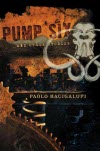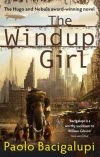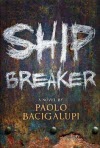The Rise & Rise of Paolo Bacigalupi
Colin Harvey takes a look at the short but hugely successful career of one of science fiction’s rising stars.
Wang Jun stood on the rain-slicked streets of old Chengdu and stared up into the drizzle at Huojianzhu. It rose into the evening darkness, a massive city core, dwarfing even Chengdu’s skyscrapers. Construction workers dangled from its rising skeleton, swinging from one section of growth to the next.
Those were the first professionally published words of a writer who, in the intervening eleven years, has won a plethora of awards, and whose short fiction has appeared a dozen times in Year’s Best selections (and is collected in Pump Six and Other Stories [Purchase]). At the time there seemed little to separate his debut from most merely competent stories of a technologically-drenched future. So what has led Paolo Bacigalupi to become the hottest SF property in years?

It has been a rapid but not an instant rise. Four years after his debut, Bacigalupi returned with “The Fluted Girl,” featuring Nia and Lidia whose bones are broken, reset and broken again until they can play tunes on each other’s clavicles, so that their patron can float shares in their performances. Better than “A Pocketful of Dharma,” it proved to be a transitional story.
His breakthrough came the following year, with “The People of Sand and Slag.” It tells of an exhausted world in which almost all life except humanity is extinct.
“If someone came from the past, to meet us here and now, what do you think they’d say about us? Would they even call us human?”
Lisa looked at me seriously. “No, they’d call us gods.”
People now live on digested sand and mud and tailings — the perfect adaptation, except that humanity has lost all compassion. Abigail Nussbaum wondered whether Bacigalupi wasn’t writing horror, and that story certainly fits the theory. It’s a view that I suspect the author wouldn’t disagree with, judging by the sentiments expressed in a Locus interview.
[I]f I wrote all the stories as nastily as the ones I have bubbling around in my gut, I would have to kill myself! After I finished a story recently, all I felt was an immense blackness.
For all its strengths, “The People” was the first story to show Bacigalupi’s less endearing traits. Too often in those early works he blatantly manipulated readers, whether through the eponymous Pop Squads who shoot babies in the head, or the expectant mothers of “Small Offerings” who deliberately miscarry, flushing the toxins from their bodies to allow them to carry the next one to term, meanwhile pitting heroic individuals against faceless corporations in a one-dimensional view of organizations exemplified by “The Tamarisk Hunter.” It’s a not unusual mix of hi-tech SF and fear of “government” 1 set apart by Bacigalupi’s environmental perspective.
While the very simplicity of his worldview appeals to readers who see life in black-and-white, there’s no denying the raw power of Bacigalupi’s prose — when Bacigalupi forsakes propaganda for fiction (as in “The Pasho”) he writes beautifully. Centuries, perhaps millennia in the future, society gropes to recover lost knowledge, held in check by the Pashos who believe that the pace of learning led to our world’s downfall:
… the old city stood silent, black bones against the sky. Raphel remembered exploring the city’s tangled ruins where hawks roosted and coyotes trotted arrogantly down streets twice the width of Keli’s greatest avenues. He remembered gathering spent shells from the mangled city, hunting for prizes from the vicious protracted wars that had destroyed the place.
“The Calorie Man” takes the reader up the Mississippi to rescue one of the architects of the destruction of the world’s habitats and “Yellow Card Man,” reads like a trial run for The Windup Girl, told from the perspective of Tranh, one of the once-rich disenfranchised Chinese refugees living in Bangkok, who spends his days hunting work.
Individually, Bacigalupi’s stories are enjoyably well-crafted; his protagonists well drawn, the settings detailed, and the science plausible. But cumulatively they’re profoundly depressing and so one-sided that the feeling of being manipulated undermines the vital suspension of disbelief — unless the reader’s worldview chimes with the author’s. So the question as I approached Bacigalupi’s debut novel The Windup Girl was could it be as bleakly one-dimensional as the stories? And if so, how could it win so many awards?

The Windup Girl [Purchase] features four people whose lives intersect in the same future Bangkok as that of “Yellow Card Man,” where a coup has left the country in an uneasy temporary equilibrium.
Captain Jaidee is “The Tiger of Bangkok,” populist hero of the Environment Ministry’s white-shirts, charged with safeguarding Thailand from the outside world. While his activities are popular with the people, he is hated by the pro-Western Trade Ministry.
Hock Seng is the yellow card man, a refugee from Malaysia who lives by his wits, while trying to avoid the random brutality of Jaidee’s cohorts. The one thing that unites Hock Seng, Jaidee and all other Thais is their contempt for The New People, as the wind-ups call themselves.
Emiko is the eponymous wind-up girl, genetically designed to please, whose sterile body betrays her with every staccato movement. Emiko was abandoned by her Japanese creators when they left Thailand, and is reduced to whoring.
Anderson Lake is an American expatriate manufacturing energy-generating kick-springs; he is Hock Seng’s employer. Lake is really a Calorie Man for one of the gene-rip companies causing the world’s problems. Lake’s job is to hunt viable seed stocks which have resisted the diseases which ravage this future world -people either die directly of infections or starve to death because the plants are dead. One of the novel’s weaknesses is that Lake is little more than a cipher – all we learn of him is his mission, and a few flashbacks to his days in the US.
Hock Seng is more complex but his back-story is recycled from “Yellow Card Man,” and Bacigalupi’s focusing on two comparatively uninteresting characters makes the opening forty pages decidedly underwhelming. The narrative only becomes interesting with the appearance of Jaidee and his lieutenant Kanya, who cause the first disruption to the political and emotional equilibrium by confiscating some vital imports destined for Lake. Soon afterward a fellow ex-pat introduces Emiko to Lake, who is immediately fascinated. He takes her back to his apartment, while news of his infatuation quickly spreads.
When Jaidee proves too successful at stopping the flow of imports he is disgraced, then killed. But martyred, he proves even more charismatic and relations between the Environment and Trade ministries deteriorate. At the same time Lake’s attempts to access to the seed-bank grow bolder and he becomes involved in a deal with the Royal protector to end the impasse created by the coup. But when Lake introduces Emiko to the Royal protector, with disastrous results, Bangkok dissolves into anarchy:
Explosions rumble across the city. A methane fire is burning, bright and green, yellowing now as it finds dry bamboo and other materials. Akkarat studies the burn, waves to the man with the radio phone. The private cranks at the power as Akkarat speaks quietly, issuing orders for fire teams to be dispatched to the blaze.
For a novel that is as initially impenetrable as the Thai jungle, The Windup Girl accelerates nicely toward its denouement, with a pleasing asymmetry to each of the main character’s fates – some die, some survive.
Further into the novel it rewards perseverance: Bangkok is well-drawn, while Bacigalupi’s future felt plausible, though I’m neither an economist nor a climatologist, and others expressed doubts about –for example — the science of kink springs. With the greater space that a novel offers its writer, Bacigalupi’s characters are far more rounded than in Pump Six. Despite its slow opening The Windup Girl is one of the best debut novels of recent years. Whether it’s good enough to win so many awards…
The literary quality of most of last year’s various Hugo, Nebula and other Best Novel ballots was as usual high, but the books tended toward fantasy, slipstream or baroque SF. Of the finalists, The Windup Girl looked more relevant than most against a backdrop of oil spillages and spiralling energy prices — especially contrasted against semi-invisible Eastern European cities, contemporary American expatriates in Japan, and zombies roaming an alternative Seattle; by accident or design, Bacigalupi has become the Voice of the Zeitgeist.
So to Ship Breaker, Bacigalupi’s first venture into the lucrative YA arena, which he talked about a couple of years ago:
I’m wondering about the creation of another set of myths and models, where we start to get excited about the possibility of being a sustainable species rather than a rapacious species.
When I think about that, I think about writing young-adult fiction. I think about writing for kids who can be inspired to develop in different ways than their parents. One of the exciting things about science fiction is that it’s been an inspirational literature for young people — when I grew up it was all about rocket ships, and boy, you sure wanted to be a NASA scientist when you’d read about rocket ships enough. And I wonder if there isn’t some way to write science fiction that says, “Boy, isn’t it cool to be a wind engineer and develop wind turbines.”

Ship Breaker [Purchase] is published by the prestigious Little, Brown imprint. But any thoughts that Bacigalupi may soften his world or characters’ callousness for younger sensibilities are swiftly dispelled. The Gulf Coast of the USA is an industrial graveyard, a bleak wreck-filled wasteland populated by children who must work while they are still small enough to clamber down narrow passages and fit into the small spaces of the rusting tankers, but who are superfluous once they grow too old; by then all but a lucky few are reduced to begging, thieving, prostitution or working as enforcers:
You should remember that, all of you. If you’re just smart, or just lucky, it’s not worth a copper yard. You got to have both, or you’re just like Sloth down at those bonfires, begging for someone to find a use for you.”
Nailer Lopez is one such crewboy scrabbling through cramped passageways hauling out copper wires for his gang-boss Bapi, while dreaming of piloting a clipper. Nailer’s mother is dead and his father, Richard, a violent alcoholic who periodically beats him, so Nailer stays occasionally with his supervisor, Pima, and her mother who provide a surrogate family at times of crisis.
All the gangs must salvage fearsome quotas of materials for sale and, when a storm threatens the coast, Bapi insists that Nailer and his assistant Sloth return below decks to bring more wire out before the bad weather hits. Working hurriedly, Nailer falls into an oil tank. Sloth wants Nailer’s job and, faced with choosing between helping him out or leaving him to drown in the oil, she abandons him. But Nailer is both smart and lucky, and survives.
The storm hits, forcing Nailer and Pima to shelter in a cave; when they emerge, they spot a clipper wrecked just off-shore. When they find a lone survivor aboard they are faced with a tough choice; do they save the young girl and hope that she will reward them when her rescuers arrive, or cut her throat and strip the vessel of everything that they can carry? Bacigalupi’s prose is so taut that it creates real tension despite the unlikelihood of a YA author having his hero commit murder.
Nailer is smart, savvy, and likeable. Bacigalupi does well to make him as powerless as most teens feel in a hostile world. When they flee to the drowned remains of Orleans II, the rescued Nita (or Lucky Girl as Nailer names her) shows her mettle as well. Nailer’s father is the villain whose instability drives the chase, but he has his moments of tenderness toward his son, making him a far more interesting villain.
Ship Breaker is narrated from a single first-person point of view which limits how much we learn of this world, but is a much simpler read than the multiple threads of The Wind-up Girl. Richard Lopez’s presence as an out-and-out villain not only gives Ship Breaker a much starker moral structure than his adult novel without the over-simplification of the Pump Six stories, but also creates a much faster tempo. And even more than in The Windup Girl, Bacigalupi ends Ship Breaker with that cautious optimism missing from much of Pump Six.
Where next for Bacigalupi? SF’s history shows that it’s easier for an author to arrive than to endure, partly because the audience is always looking for the new. There have been many writers whose stellar early promise faded before the relentless demands of publishers and audience. Bacigalupi has had to learn in public, but has done so to good effect. Ship Breaker‘s appearance on the National Book Award shortlist hints that Baclgalupi’s rise is not yet done2.
1. In this case, government is a synonym for any centralized — or even non-local — organization that’s much bigger than a village.
2. As does the news just before Salon Futura went to press that the American Library Association has awarded Paolo Bacigalupi the 2011 Michael L. Printz Award for his novel, Ship Breaker. The Printz Award is presented for excellence in literature written for young adults.